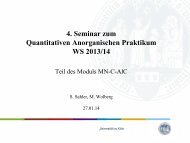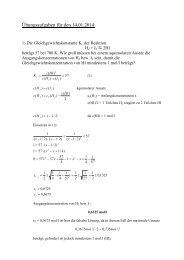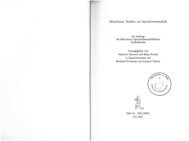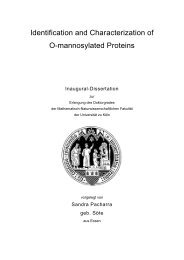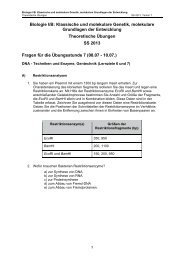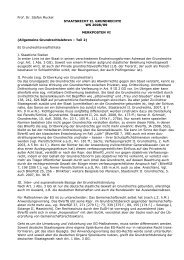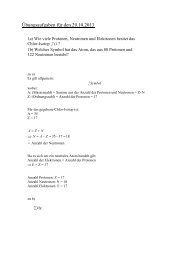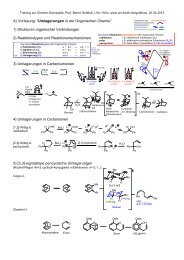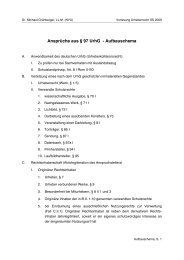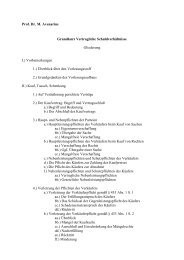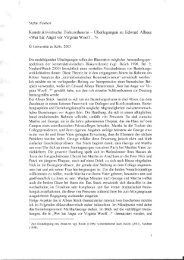Inhibition of Contractile Vacuole Function by ... - Universität zu Köln
Inhibition of Contractile Vacuole Function by ... - Universität zu Köln
Inhibition of Contractile Vacuole Function by ... - Universität zu Köln
You also want an ePaper? Increase the reach of your titles
YUMPU automatically turns print PDFs into web optimized ePapers that Google loves.
210<br />
malian cells, BFA targets a subset <strong>of</strong> sec7-type GTP exchange<br />
factors (GEFs) that catalyse the activation <strong>of</strong> small GTPases<br />
called ARFs (Jackson and Casanova 2000). ARF1 is the best<br />
studied member <strong>of</strong> this protein family. Upon binding <strong>of</strong> GTP,<br />
ARF1 is responsible for the formation <strong>of</strong> COP1-coated vesicles<br />
at the Golgi complex as well as the formation <strong>of</strong> clathrin/<br />
AP1-coated vesicles at the trans-Golgi network (TGN) (Scales<br />
et al. 2000, Spang 2002). The molecular targets <strong>of</strong> BFA have<br />
been found in the Arabidopsis genome (Cox et al. 2004) and it<br />
is generally assumed that the primary BFA effect is similar in<br />
plants and in animals (for a recent review see Nebenführ et al.<br />
2002). This study revealed that the initial effect <strong>of</strong> BFA on the<br />
structure <strong>of</strong> the Golgi complex is also similar in S. dubia. The<br />
Golgi stacks lose the peripheral transition vesicles and the<br />
number <strong>of</strong> cisternae decreases as in land plants. Maturation <strong>of</strong><br />
cisternae during the fist minutes seemed to continue, as 10 min<br />
after addition <strong>of</strong> BFA all cisternae contained scales, whereas in<br />
control cells the first two to three cis-most cisternae were generally<br />
devoid <strong>of</strong> scales. In S. dubia, we observed a second<br />
effect <strong>of</strong> BFA. The CVs swelled and failed to discharge their<br />
contents into the medium. In this study, we have presented evidence<br />
that the CV in Scherffelia develops from the SR. Since<br />
we could not observe a connection between the SR and the<br />
round vacuole at a late diastole phase, we propose that during<br />
the CV cycle, the developing round vacuole and the SR are disconnected<br />
(Fig. 10), a process which is analogous to late steps<br />
in vesicle budding and which might be regulated <strong>by</strong> an ARF<br />
protein. BFA might inhibit this process which then leads to the<br />
observed swelling <strong>of</strong> the vacuole (Fig. 10).<br />
Beside the inhibition <strong>of</strong> the retrograde transport from the<br />
Golgi to the endoplasmic reticulum, BFA induced in land<br />
plants the formation <strong>of</strong> a Golgi-derived ‘conglomerate <strong>of</strong><br />
tubules and vesicles’ termed the BFA compartment (Satiat-<br />
Jeunemaitre et al. 1996) which also included endocytotic compartments<br />
(reviewed in Nebenführ et al. 2002), and inhibited<br />
endocytosis <strong>of</strong> a styryl dye in BY-2 cells (Emans et al. 2002),<br />
indicating that also in land plants BFA acts on post-Golgi compartments.<br />
It is currently not known whether the BFA effect on<br />
the endocytotic pathway has the same molecular basis as the<br />
Golgi effect. In this context, it is interesting that we recently<br />
have found in our expressed sequence tag (EST) sequencing<br />
project <strong>of</strong> the prasinophyte M. viride three different cDNAs for<br />
a class 1 ARF protein in interphase cells (A. Simon and B.<br />
Becker, unpublished). The CV function in Mesostigma is also<br />
inhibited <strong>by</strong> BFA (this study). Therefore, it seems possible, that<br />
a specific ARF might exist which is involved in regulating the<br />
CV function in freshwater prasinophyte algae.<br />
Whether the SR has to be disconnected as a prerequisite<br />
for exocytosis during the CV cycle, or whether BFA also interfered<br />
directly with exocytosis <strong>of</strong> the CV is currently an open<br />
question. Another possibility is that COP1- and/or clathrin/<br />
AP1-mediated vesicular transport is required for proper function<br />
<strong>of</strong> the CV. In this case, the observed effect <strong>of</strong> BFA on the<br />
function <strong>of</strong> the CV would be an indirect one. However, the lat-<br />
The contractile vacuole <strong>of</strong> S. dubia<br />
ter model cannot easily explain the observed consumption <strong>of</strong><br />
the SR <strong>by</strong> the growing LCVs. Additional work will be required<br />
to resolve this issue.<br />
Several different species <strong>of</strong> green algae have been treated<br />
with BFA, but a BFA effect on the CV has, to our knowledge,<br />
never been reported before (e.g. Dairman et al. 1995, Salomon<br />
and Meindl 1996, Haller and Fabry 1998, Noguchi et al. 1998,<br />
Domozych 1999, Noguchi and Watanabe 1999, Callow et al.<br />
2001). All <strong>of</strong> the tested species are either marine (Enteromorpha),<br />
do not possess a CV (Micrasterias, Closterium,<br />
Scenedesmus) or belong to the volvocalean algae (which<br />
includes Chlamydomonas), which explains why a BFA effect<br />
on the CV has not been reported yet. Therefore, a brief survey<br />
<strong>of</strong> the BFA effect on the CV in green flagellates was undertaken.<br />
All tested scaly green flagellates showed an effect <strong>of</strong><br />
BFA on the CV. However, only S. dubia and T. cordiformis<br />
developed LCVs, whereas in P. tetrarhynchus and M. viride, no<br />
LCV formation was observed. BFA interfered with CV function<br />
in both species, and the cells swelled and finally burst in<br />
hypotonic media. In contrast, no BFA effect on the CV <strong>of</strong><br />
Chlamydomonas was observed (Robinson 1993, Haller and<br />
Fabry 1998, this study). <strong>Inhibition</strong> <strong>of</strong> CV function <strong>by</strong> BFA<br />
seems to be common within prasinophytes which represents the<br />
ancestral stock from which all other green algae and the land<br />
plants evolved (Nakayama et al. 1998, Chapman and Waters<br />
2002), but not all prasinophyte develop an LCV. In addition,<br />
the absence <strong>of</strong> any BFA effect in Chlamydomonas and other<br />
volvocalean algae (Dairman et al. 1995) indicates that<br />
advanced chlorophyte algae might have lost the BFA sensitivity<br />
<strong>of</strong> the CV.<br />
To summarize, cells <strong>of</strong> S. dubia treated with BFA fail to<br />
terminate the early diastole phase <strong>of</strong> the CV cycle. The cells<br />
continue to accumulate ions in the CV, which leads to additional<br />
water uptake and swelling <strong>of</strong> the CV. This basically represents<br />
a prolonged diastole phase. A normal diastole phase<br />
takes about 20 s and is therefore difficult to investigate. Therefore,<br />
we conclude that BFA-induced formation <strong>of</strong> LCVs in S.<br />
dubia will represent a unique model system to investigate the<br />
diastole phase <strong>of</strong> the CV cycle.<br />
Materials and Methods<br />
Strains and culture conditions<br />
Scherffelia dubia Pascher emend. Melkonian et Preisig (Melkonian<br />
and Preisig 1986) strain CCAC019 was obtained from the Culture<br />
Collection <strong>of</strong> Algae at the University <strong>of</strong> Cologne and cultured as<br />
previously described (Grunow et al. 1993). Mesostigma viride Lauterborn,<br />
Tetraselmis cordiformis (Carter) Stein and Pyramimonas tetrarhynchus<br />
Schmarda were kindly provided <strong>by</strong> Dr. M. Melkonian<br />
(Botanical Institute, University <strong>of</strong> Cologne) and cultured in 100 ml<br />
Erlenmeyer flasks containing 50 ml <strong>of</strong> a modified Waris solution<br />
(McFadden and Melkonian 1986b) at 15°C and a 14/10 light/dark<br />
cycle. Chlamydomonas reinhardtii strain CC-3395 was kindly provided<br />
<strong>by</strong> Dr. K.-F. Lechtreck (Botanical Institute, University <strong>of</strong><br />
Cologne) and cultured in TAP medium in a 14/10 light/dark cycle at<br />
25°C.



